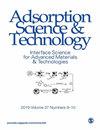A Comprehensive Insight on Adsorption of Polyaromatic Hydrocarbons, Chemical Oxygen Demand, Pharmaceuticals, and Chemical Dyes in Wastewaters Using Biowaste Carbonaceous Adsorbents
IF 3.2
4区 工程技术
Q2 CHEMISTRY, APPLIED
引用次数: 4
Abstract
Recent trends in adsorption of hazardous organic pollutants including Polyaromatic Hydrocarbons (PAHs), Chemical Oxygen Demand (COD), Pharmaceuticals, and Chemical Dyes in wastewater using carbonaceous materials such as activated carbon (AC) and biochar (BC) have been discussed in this paper. Utilization of biomass waste in the preparation of AC and BC has gained a lot of attention recently. This review outlines the techniques used for preparation, modification, characterization, and application of the above-mentioned materials in batch studies. The approaches towards understanding the adsorption mechanisms have also been discussed. It is observed that in the majority of the studies, high removal efficiencies were reported using biowaste adsorbents. Regarding the full potential of adsorption, varying values were obtained that are strongly influenced by the adsorbent preparation technique and adsorption method. In addition, most of the studies were concentrated on the kinetic, isotherm equilibrium, and thermodynamic aspects of adsorption, suggesting the dominant isotherm and kinetic models as Langmuir or Freundlich and pseudo-second-order models. Due to development in biosorbents, adsorption has been found to be increasingly economical. However, application of these adsorbents at commercial scale has not been adequately investigated and needs to be studied. Most of the studies have been conducted on synthetic solutions that do not completely represent the discharged effluents. This also needs attention in future studies.利用生物废物碳质吸附剂对废水中多环芳烃、化学需氧量、药物和化学染料的吸附
本文讨论了利用活性炭(AC)和生物炭(BC)等含碳材料吸附废水中有害有机污染物(包括多环芳烃(PAHs)、化学需氧量(COD)、药物和化学染料)的最新趋势。近年来,利用生物质废弃物制备AC和BC引起了人们的广泛关注。这篇综述概述了上述材料的制备、改性、表征和在批量研究中的应用技术。还讨论了理解吸附机理的方法。据观察,在大多数研究中,使用生物废物吸附剂的去除效率很高。关于吸附的全部潜力,获得了不同的值,这些值受到吸附剂制备技术和吸附方法的强烈影响。此外,大多数研究都集中在吸附的动力学、等温线平衡和热力学方面,表明主要的等温线和动力学模型为Langmuir或Freundlich和伪二阶模型。由于生物吸附剂的发展,吸附已被发现越来越经济。然而,这些吸附剂在商业规模上的应用尚未得到充分的研究,需要进行研究。大多数研究都是在合成溶液上进行的,这些溶液并不完全代表排放的废水。这也需要在未来的研究中予以关注。
本文章由计算机程序翻译,如有差异,请以英文原文为准。
求助全文
约1分钟内获得全文
求助全文
来源期刊

Adsorption Science & Technology
工程技术-工程:化工
CiteScore
5.00
自引率
10.30%
发文量
181
审稿时长
4.5 months
期刊介绍:
Adsorption Science & Technology is a peer-reviewed, open access journal devoted to studies of adsorption and desorption phenomena, which publishes original research papers and critical review articles, with occasional special issues relating to particular topics and symposia.
 求助内容:
求助内容: 应助结果提醒方式:
应助结果提醒方式:


